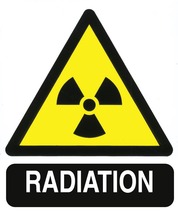Case• 29. Caution – X-rays
SUMMARY
A patient does not wish to have radiographs taken. How should her concerns be answered?
 |
| Fig. 29.1. |
History
Complaint
Following clinical examination, you decide that a patient attending your practice for the first time requires the following radiographs:
| View | Reason |
|---|---|
| Right and left bitewings | To assess existing restorations and periodontal status |
| Periapical radiograph of the lower left first molar | This tooth is tender to percussion and may need extraction or root canal treatment |
| Panoramic radiograph | To assess partially erupted wisdom teeth |
The patient is concerned about radiation and is not sure whether she wishes to have so many films taken.
▪ What three general guiding principles must you follow in deciding whether or not to undertake any radiographic examination?
Justification. Each radiation exposure must have a net positive benefit.
Optimization. The exposures must be at a dose which is As Low As Reasonably Practicable (ALARP), taking social and economic factors into account.
Limitation. The dose to individuals must not exceed recommended limits.
The principles are set out by the International Commission on Radiological Protection (ICRP) who also set the recommended limits.
▪ What is the patient dose associated with these radiographs?
Radiation dose measuring is complex. The effective dose (absorbed dose corrected to compensate for the type of radiation and susceptibility of different tissues) is usually quoted. The effective dose from an intraoral radiograph (periapical or bitewing) is in the range of 0.001–0.008 milliSieverts (mSv) and for a panoramic is in the range 0.016–0.026 mSv.
▪ As this does not mean much to most people, how can you reassure the patient?
The patient can be reassured that the doses are very small and equivalent to a tiny fraction of the natural background radiation to which we are all exposed every day. If the patient wants to know actual figures then she should be told that the annual dose from background radiation varies around the world, but for example the average in the UK is 2.6 mSv and in the USA is 3.5 mSv. The dose from the radiographs required equates to approximately 16 hours of background radiation for an intraoral film or 2 days for a panoramic film.
▪ The patient accepts this but points at the hazard warning sticker on your X-ray cubicle. What exactly are the risks?
At these low absorbed doses there is only one significant risk, that of developing a malignant neoplasm. This is a very low frequency and completely random (stochastic) effect induced by damage to DNA.
The risk of developing malignancy from a periapical radiograph varies between 1 in 2 million to 1 in 20 million depending on the equipment used, the speed of the image receptor and the length of the exposure time.
For a panoramic radiograph the risk varies between 0.21 and 1.9 per million, again depending on the equipment used and the type and speed of the image receptor (film/screen combination or digital).
▪ The patient wants to know how you ensure that she will receive the minimum dose of radiation necessary. What methods limit the dose to patients and how do they work?
Methods of dose limitation can be divided into three groups as shown in Table 29.1.
| Precaution | Reason | |
|---|---|---|
| Equipment | The X-ray set should operate at 70 kV | This produces the optimum energy X-rays for dental radiography, the best balance between tissue penetration and image contrast. |
| The X-ray set should contain aluminium filtration in the beam path | To absorb most of the low energy X-rays that would otherwise be absorbed by the skin. These would increase the patient dose and would not contribute to the radiographic image. | |
| X-ray sets for intraoral radiography should have a rectangular collimated beam | To reduce the width of the beam to the minimum required to cover the film. This makes it more difficult to aim the beam accurately and so a film holding and beam aligning device will be required. | |
| The X-ray set should be checked for safety on installation and regularly thereafter | This must include, in particular, checks on the tube kilovoltage, as this determines dose, and to ensure no X-rays leak from the back and sides of the unit. | |
| Image receptors should be as sensitive as possible, i.e. E or F speed film or digital receptors to ensure the shortest exposure times | Faster detectors reduce the dose required. Digital receptors are the most sensitive. | |
| Extraoral radiographs should be taken using cassettes ideally containing rare-earth intensifying screens or digital receptors | These amplify the X-ray signal within the cassette and thus reduce the dose required. | |
| Clinical judgement | Patients should only be X-rayed if the investigations are clinically necessary, i.e. they can be justified following a thorough clinical examination | Unnecessary radiographs give an unnecessary X-ray dose. |
| Published evidence-based ‘selection criteria’ should be used during the justification process |
Stay updated, free dental videos. Join our Telegram channel

VIDEdental - Online dental courses


